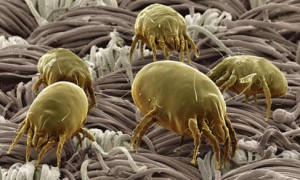
More evidence that low-calorie sweeteners are bad for your health
Studies show that artificial sweeteners can raise the risk of hypertension, metabolic syndrome, type 2 diabetes and heart disease, including stroke.

If you are suffering from a chronic runny nose it might not be the weather – the problem could be dust mites.
House dust mites are tiny creatures, about a quarter of a millimetre long. They live in our bedding, carpets, soft furnishings and clothing and feed on human skin scales and thrive in humid environments.
Every house has dust mites and their presence is not an indication that your house is ‘dirty’.
Just like our skin contains whole populations of bacteria and fungi, all houses have dust mites. If your house is centrally heated and has double glazed windows, fitted carpets and loft and wall insulation, you are making a cozy home for yourself – but for your dust mites as well!
Higher indoor temperatures mean more humidity- and this makes a perfect a breeding ground for these little critters. As a result house dust mite allergy is becoming very common and according to recent evidence is associated with an increased risk of developing asthma, eczema and allergic rhinitis.
In people allergic to dust mite, it is often not the mite itself but proteins in their droppings which cause the allergy. Each mite produces about 20 of these waste droppings every day and the droppings continue to cause allergic symptoms even after the mite has died.
Regular cleaning is the best way to control dust mites. Measures to avoid house dust mite will lower, but can’t totally remove dust mite allergens. For many, but not all people, this will be sufficient to significantly improve symptoms.
At the same time scientists continue to debate whether some exposure to dust mites and other household allergens has a strengthening effect in the long-term and whether a too-clean home is debilitating.
What to do?
There is no way to predict whether someone will benefit from measures to reduce dust mite allergens, except by trying them. To have the best chance of improving your health it is best to try several measures at the same time and to keep the routine up regularly.
Start with the bedroom A significant amount of exposure to house dust mite allergen happens in the bed. We spend a third of our lives in bed so taking precautions in the bedroom by using allergy-proof covers on bedding, and regularly washing all bedding including sheets, blankets, pillowcases and duvets.
However, remember that dust mite allergen is found in all rooms of the house, on the floor and in soft furnishings, not just in the bedroom, so vacuum carpets and couches regularly, particularly under and behind pillows.
The power of steam Regular steam cleaning is the best way to keep your carpet free of microscopic pests. It may be expensive but some may reason it is worth the money since the very hot water used in steam cleaners kills dust mites, fleas, bacteria and mould as well as cleaning.
Wash those rugs Throw rugs should be laundered regularly, if possible. Non-washable rugs should be shaken outside or hung on a line and beaten with an old-fashioned rug beater or old tennis racket.
Air filters Use home HEPA (high efficiency particulate absorption) air filtration units to remove mites and their fecal matter (itself an allergen) from the air.
Vacuum filters Look for a vacuum with a micro-particle filter that can trap mites.
Dehumidify. Mites and moulds prefer humidity levels over 50%. If your air contains too much moisture, use a dehumidifier.
Ditch carpets While it’s not a solution that everyone will want, carpets are a major source of dust mite allergens. If you are really suffering, consider replacing carpets with solid flooring. resist the urge to install wall-to-wall carpet in your house
Open a window It’s better than using an air freshener (and regular use of these synthetic fragrances can also trigger allergies) and when the weather is warm airing out your home will help reduce mite allergens.
Get outside. Alwasy being inside, is like always eating the same foods – eventually your body will rebel. Studies show that too little contact with biodiverse natural environments is one reason more city dwellers are developing allergies and asthma.
Strengthen yourself from the inside
Diet may play a role in making you more sensitive to certain allergens. Regular use of certain medications, such as antibiotics, may also make you, and especially your children more susceptible to allergic reactions. Strengthening your gut by regularly supplementing with probiotics may help – particularly for children. A daily multivitamin is important to supplement poor diet and counteract stress (see our tips for choosing quality supplements). Increasing your intake of healthy fats may also be supportive.
Acupuncture can help ease seasonal allergies and may help support your system in cases of dust mite allergy. Natural measures to deal with hay fever, may also bring relief in cases of dust mite allergy. In particular, elderflower tea is a mild decongestant that will help to clear the nose, it is also pleasant tasting.
Finally there is some evidence that regular exposure to cosmetic ingredients like triclosan and parabens can make us more sensitive to asthma and allergies – so use better quality products.

Please subscribe me to your newsletter mailing list. I have read the
privacy statement